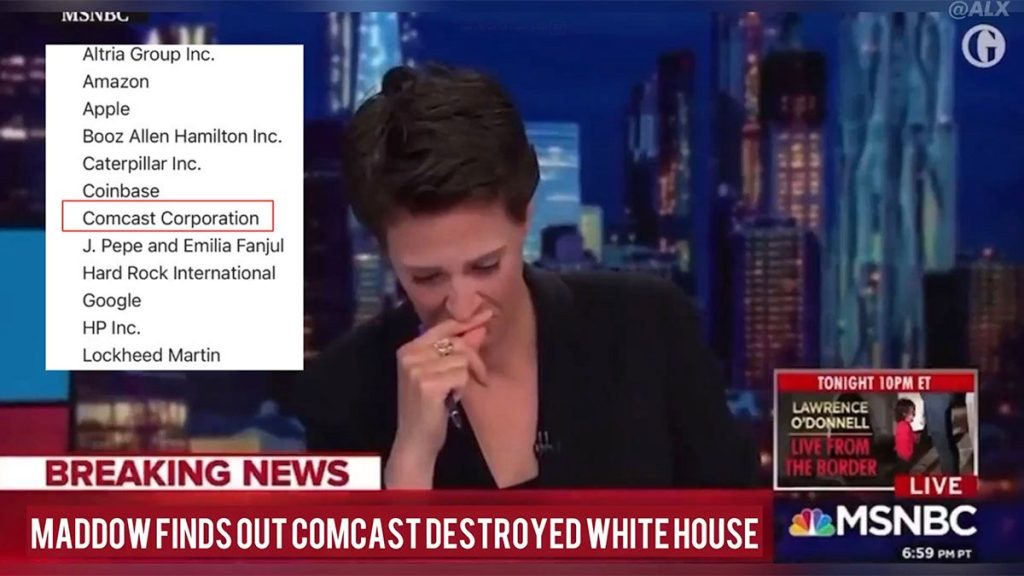Listen to the article
AI-Generated Maddow Video Fuels Misinformation About White House Demolition
Meta’s social media platform Threads sparked confusion last week when it promoted a manipulated video purportedly showing MSNBC host Rachel Maddow becoming emotional over the demolition of the White House East Wing.
On October 24, 2025, Threads featured a trending topic reading “Rachel Maddow reacts emotionally to White House renovation plans” with an accompanying image of the MSNBC host appearing distressed. When users clicked on the trending topic, they were shown a video of Maddow seemingly holding back tears about the White House renovations that had begun earlier that week.
The misleading content spread quickly across multiple platforms, including Facebook and LinkedIn, despite being completely fabricated.
An investigation revealed that the video was doctored by an X (formerly Twitter) user who had altered footage from a 2018 episode of “The Rachel Maddow Show.” The creator added a fabricated chyron reading “Maddow Finds Out Comcast Destroyed White House” and included a list of alleged donors to the White House renovation project. Shortly after posting the video, the creator acknowledged in a reply that it was “a meme (obviously).”
The incident highlights the dangerous intersection of AI-generated content and platform amplification. Threads’ trending topic description carried a small disclaimer reading, “What people are saying, summarized by AI,” but this was insufficient to prevent the spread of misinformation.
The authentic footage of Maddow becoming emotional dates back to June 19, 2018, when she was reporting on an Associated Press article about migrant children being separated from their parents at the U.S.-Mexico border and placed in “tender age” shelters. The segment had absolutely no connection to White House renovations.
Further complicating matters, Maddow only broadcasts her show on Monday evenings. During her most recent episode prior to the trending topic—aired on October 20—she briefly mentioned the beginning of the East Wing demolition but showed no emotional reaction.
The actual White House East Wing demolition is part of a controversial renovation plan that includes the construction of a new ballroom. According to reports from BBC, PBS, and other news organizations, the project has raised questions about funding and ethics, with multiple donors contributing to the estimated $300 million project.
While some users attempted to correct the misinformation through community notes—one note on Threads stated, “This clip is from 7 years ago and completely unrelated to the destruction of the White House”—the damage had already been done through widespread sharing.
This isn’t the first time this particular X user has created misleading content using the same 2018 footage of Maddow. A previous fabricated video claimed to show her reaction to the possibility of tech billionaire Elon Musk purchasing MSNBC.
The incident raises serious concerns about content moderation on social media platforms and the role of AI in curating trending topics. Meta, Threads’ parent company, has not yet responded to requests for comment about how this misleading content became a trending topic on its platform.
As digital manipulation tools become more sophisticated and accessible, distinguishing between authentic and fabricated content grows increasingly challenging for both platforms and users, creating fertile ground for the rapid spread of misinformation.
Verify This Yourself
Use these professional tools to fact-check and investigate claims independently
Reverse Image Search
Check if this image has been used elsewhere or in different contexts
Ask Our AI About This Claim
Get instant answers with web-powered AI analysis
Related Fact-Checks
See what other fact-checkers have said about similar claims
Want More Verification Tools?
Access our full suite of professional disinformation monitoring and investigation tools




8 Comments
While it’s concerning to see manipulated videos spread so quickly on social media, I’m encouraged that fact-checkers were able to identify and debunk this particular piece of misinformation. Maintaining a healthy skepticism and cross-checking sources is crucial in the digital age.
While I’m concerned about the potential for AI-generated misinformation to sow confusion, I’m hopeful that advancements in detection and fact-checking will help curb the spread of these types of manipulated videos in the future.
This seems like a clear case of misinformation. I’m glad the investigation revealed the video was doctored and the claims are fabricated. It’s important to be vigilant about verifying the authenticity of online content, especially around sensitive political topics.
Manipulated videos like this one underscore the need for robust fact-checking and transparency from social media platforms. Proactive measures to identify and remove misinformation are crucial for preserving the integrity of public discourse.
It’s disheartening to see how quickly fabricated content can spread in today’s digital landscape. However, I’m encouraged by the investigative efforts that exposed this particular video as a hoax. Continued vigilance is key.
This is a reminder of the importance of media literacy and critical thinking when it comes to online content. While new technologies enable creative expression, they can also be used to spread harmful falsehoods.
Doctored videos like this one are particularly insidious as they can seem convincing at first glance. I’m glad the creators eventually acknowledged the video was fabricated, but the initial spread of misinformation is still concerning.
The use of AI to create misleading content is a growing problem that requires careful monitoring and fact-checking. I hope platforms continue to improve their ability to detect and remove fabricated videos and other forms of disinformation.